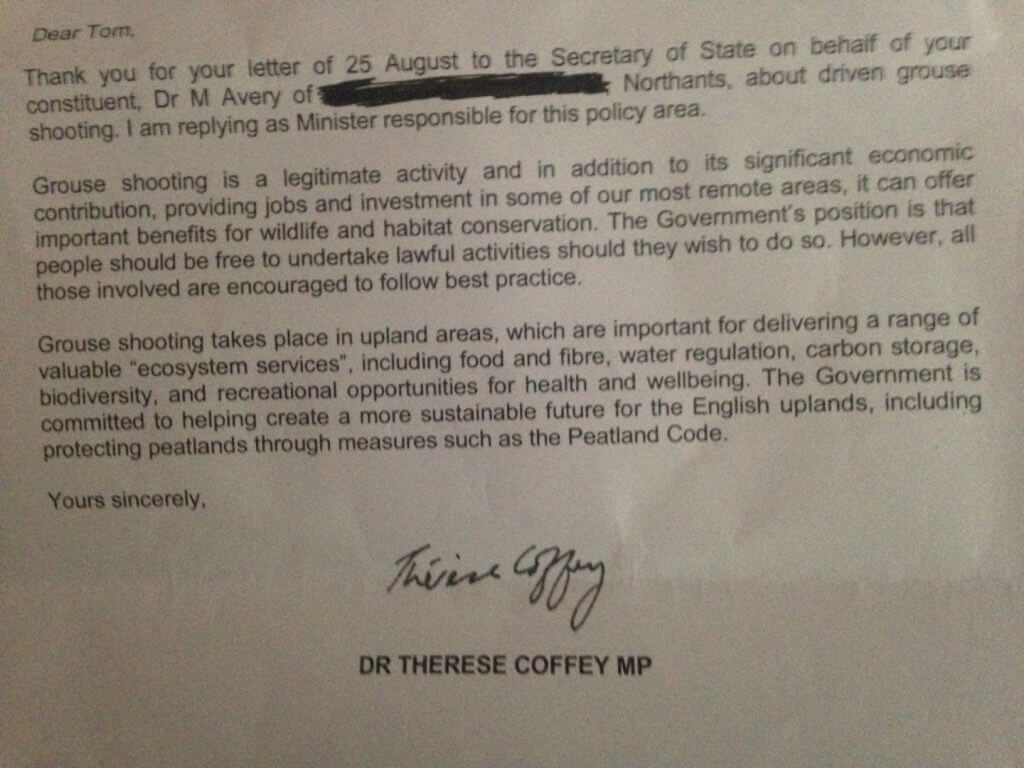If you received this letter from Defra via your MP, and many of you have, you could write back and ask for better information. That’s what I’ve done and you might find my letter a useful model to follow.
Dear Mr Pursglove
Thank you for the response from Dr Coffey that you sent me. You described it as a substantive response whereas I would describe it as very insubstantial. I’d be grateful if you could pass this letter to Defra for further clarification and ask for their reply to reach me by 18 October so that I can refer to it in the oral evidence that I will give the House of Commons Petitions Committee Inquiry into this subject which has been triggered by my e-petition to ban driven grouse shooting (which amassed 123,075 signatures, 215 of them from Corby).
There are two areas needing clarification: economics of grouse shooting and ecosystem services.
- Economics of grouse shooting:
Dr Coffey’s letter refers to the economic contribution of grouse shooting as being ‘significant’. How significant? I’m glad to see that Defra has stopped using flawed shooting industry estimates for the amount of money spent on grouse shooting – those figures have been criticised by others as being overestimates. They are derived from the industry which has a vested interest in making those figures look big. They include public expenditure which would remain in the uplands if driven grouse shooting ceased and they are a simple list of benefits and make no account to offset the economic damage done by intensive moorland management. What work has Defra done to produce reliable estimates of the nett benefits or costs of driven grouse shooting? Where are these published? What is the basis for the claim that the economic contribution of grouse shooting is ‘significant’.
- Ecosystem services:
Grouse shooting does take place in uplands which are important for delivering a range of ecosystem service: the trouble is that there is good evidence that intensive grouse moor management reduces those societal benefits. Has Defra studied these impacts? Has it costed their nett value?
Is Defra aware of the EMBER study (Brown L.E., Holden J. and Palmer S.M. (2014) Effects of moorland burning on the ecohydrology of river basins. Key findings from the EMBER project. University of Leeds.)?
Is Defra aware of this follow up to the EMBER report (Holden, J., S. M. Palmer, K. Johnston, C. Wearing, B. Irvine, and L. E. Brown (2015), Impact of prescribed burning on blanket peat hydrology, Water Resour. Res., 51, 6472–6484, doi:10.1002/2014WR016782.)?
Is Defra aware of the 2015 report by the Committee on Climate Change which stated ‘The damaging practice of burning peat to increase grouse yields continues, including on internationally protected sites’. https://www.theccc.org.uk/wp-content/uploads/2015/06/6.738_CCC_ExecSummary_2015_FINAL_WEB_250615.pdf
Is Defra aware of this scientific paper which documents the increasing intensity of moorland management for driven grouse shooting (David J.T. Douglas, Graeme M. Buchanan, Patrick Thompson, Arjun Amar, Debbie A. Fielding, Steve M. Redpath and Jeremy D. Wilson (in press) Vegetation burning for game management in the UK uplands is increasing and overlaps spatially with soil carbon and protected areas. Biological Conservation, 191, 243-250.)?
What are the implications of these studies for calculating the nett benefits of grouse shooting to the economy as a whole?
Yours sincerely
Dr Mark Avery
[registration_form]
Mark
You might find this interesting
http://www.energyroyd.org.uk/archives/15838
If you don’t know about it already!
Regards
Tim
It’s extremely interesting, Tim – in fact, it’s about the clearest and most hard-hitting article I’ve read on the effects of moorland burning on water run-off.
Very useful grist for Mark’s mill!
It also highlights the now familiar story of how voluntary codes have failed to achieve worthwhile improvements.
I believe Walshaw Moor is 16,000 acres (25 sq miles). The water retention and flow control potential of Sphagnum and underlying peat is vast as this vid from a young Ray Mears makes clear: https://m.youtube.com/watch?v=GRmpvxNBB0Q
Wonderful, that’ll send poor Defra scuttling along the ‘metaphoric’ corridors to see if their mates have any more spin which can be proffered as ‘evidence’ or ideas to counter their failure to properly validate unsubstantiated claims?
I suspect it will be the economic case that will carry the day?
Sadly the impact on peoples homes and businesses and the associated misery wrought by exacerbated flooding, costs to service users to redress water quality issues and illegal persecution of raptors are unlikely to be of interest to many in Parliament who may well have potential conflicts of interest?
Mark – I am sure you have seen this article on the RSPB HH blog – but just in case you have not:
http://www.rspb.org.uk/community/ourwork/skydancer/b/skydancer/archive/2016/09/23/guest-blog-mortality-in-montagu-39-s-harriers-as-revealed-by-satellite-tracking.aspx
The interesting point in this article which relates to the Hen Harriers in UK is the reliability demonstrated by the satellite tracking euipment. As we all know, most of the sat tracked HHs in England are not going off the radar because the equipment has failed but this is what the shooters will try and say. This needs to be demonstrated to the MPs on the 18th October. Total number tagged, total number still transmitting (probably zero if this years are backed out), where the transmitters last sent out a signal, what was found there. The information is readily available, I recall downloading it a while ago, probably from NE. Of course we all know that the sat transmitters don’t work underground or after being burnt.